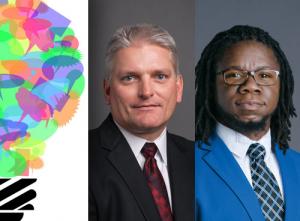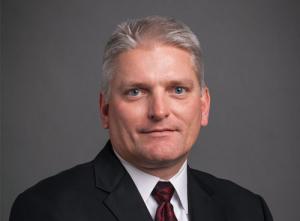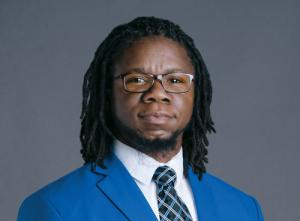Burns & McDonnell
Andy Jarvis is Vice President at Burns & McDonnell Transmission & Distribution.
Ron Evans is T&D Business Diversity Director at Burns & McDonnell.
PUF examines our industry's drive to diversify its workforce and spend. This section focuses on the progress at Burns & McDonnell.

PUF: Why is diversity in the utilities industry, both in the workplace and in the utility spend, so important to Burns & McDonnell?
Andy Jarvis: Burns &McDonnell has been in business for a hundred and twenty-three years and one of our key drivers of success all along has been diversity. That's diversity in our business lines, our locations, our workforce, and our partnerships.
We want to add value to our utility customers through seeking ways to improve on our diversity, equity, and inclusion practices. We like to hear what they're doing with respect to efforts in diversity, equity, and inclusion.
We feel like events such as the Utility Diversity Roundtable is an opportunity for us to collaborate on ideas and seek ways to improve on the successes they've had, and we've had, and have an open and honest conversation about where we need to improve.
 Andy Jarvis: We’re an employee-owned company. We own what we do. It’s important for us to embrace diversity, equity, and inclusion in all of our practices.
Andy Jarvis: We’re an employee-owned company. We own what we do. It’s important for us to embrace diversity, equity, and inclusion in all of our practices.
Constantly, we recognize the need to improve in all aspects of diversity, equity, and inclusion. Likewise, our utility partners want to improve, and they seek the same opportunities to share best practices.
We want to support our utilities in their efforts. We support them in a lot of our services providing engineering, construction, and program management services.
I see this as one more way to add value to what they do and add value to their customers because ultimately, their customers are our customers. We want to support and be a partner in their diversity, equity, and inclusion efforts.
It's the right thing to do for us as a company. We're an employee-owned company. We own what we do. It's important for us to embrace diversity, equity, and inclusion in all of our practices.
 Ron Evans: Since we work for the utilities to design and build the infrastructure that supports the community, that is what makes us partners when it comes to diversity, equity, and inclusion.
Ron Evans: Since we work for the utilities to design and build the infrastructure that supports the community, that is what makes us partners when it comes to diversity, equity, and inclusion.
PUF: Ron, you've been working on this for a few years. What's your take on why this is so important? I'd also like your perspective on how things evolved over the last four or five years.
Ron Evans: Andy touched on some key aspects of why this is so important to us with utilities. One of the main points is when we consider the community, that being the customers the utilities serve.
We are a part of the same communities as their customers with any project we design and build. It is ultimately the community who Burns & McDonnell is serving by the projects we design and build.
That connects us in a strong way. Since we work for the utilities to design and build the infrastructure that supports the community, that is what makes us partners when it comes to diversity, equity, and inclusion.
That's why we are so invested into utilities, with what they think, how they feel, and what priority they give diversity, equity, and inclusion, but also to share with them that we have the same concern and commitment.
As far as what has evolved, I attended the AABE Energy Summit in 2017. That was where I got an intro to what was going on in the utility space with respect to diversity, equity, and inclusion.
One of the main things I've noticed evolve is more utilities are talking about this topic. Back then, there were only a few that I knew about that were fully engaged. Now, the majority of utilities that we have a relationship with have communicated a strong focus on diversity, equity, and inclusion.
I also think last year was a huge inflection point that no one will forget. It was one of those periods that has driven or nudged every industry in a way, that we're going to remain committed to these efforts, to make sure we all are treating one another in the ways that we should be treated as a people, as humanity.
PUF: How did Burns & McDonnell respond to the events of last summer?
Andy Jarvis: We talked about it. Ten years ago, those discussions wouldn't have happened. It wasn't something you talked about. It wasn't a topic you brought up at work. It was, that's outside of work, and we're going to focus on work.
As we've changed as a society, and as our company has changed, we have those conversations now, and we have the freedom and a safe environment to talk and listen. That is because, as we've matured as an organization and understand the impact some of this is having on our employee owners, we need to have those platforms for discussions.
Leadership needs to understand, be sensitive, and be willing and able to have those tough conversations. Some of these conversations are difficult.
We have a new forum that is specifically in our T&D Group, it is one that Ron created. It's called Real Talk. It's a forum where we have employee-owners from all levels of the organization participate and talk about exactly what we're talking about here and share their thoughts and feelings.
I sat in on one of the talks. It was eye opening for me. It gave me a perspective that, as a leader, I have to understand the viewpoints other people have in my organization and be open and aware. I wouldn't have had that opportunity to listen, had it not been for Real Talk, had it not been for that forum or platform we've created in T&D at Burns & McDonnell.
We have other platforms too, such as a corporate diversity advisory committee, where we have the opportunity to share thoughts, beliefs, and concerns over what's happening outside the walls of Burns & McDonnell.
PUF: How did you all think about putting this together to make it work?
Ron Evans: Andy is my boss, and his boss is COO, John Olander. Without their leadership getting behind an idea like that, it wouldn't have been possible.
It came from having conversations with people and hearing their concerns. We had already started to have a multicultural perspectives lunch, within our T&D Group. We had been having those for about two years, from 2018 to 2020.
As I was brainstorming with people who were part of those conversations, I said, we need to start talking about this at a greater level within our organization. It's necessary because we realized that it benefits our organization, and community.
PUF: How do you develop partners and subcontractors that can work with you on these big, and crucially important projects?
Andy Jarvis: It starts with being intentional. Ron Evans is the T&D business diversity director. That's a relatively new role. We also have a firm-wide business diversity director with Michelle Word who helps in developing partnerships with diverse businesses.
Some of the things we do with respect to our diverse suppliers and subcontractors starts with Ron educating our execution teams, project managers, and account managers on how to engage diverse suppliers and subcontractors.
We have a large database of diverse suppliers. Ron has been creating deep relationships with those diverse suppliers, as well as some other folks in our organization. It's connecting those diverse suppliers and subcontractors with our project execution. One of his key roles is helping develop processes and procedures to connect our project teams and managers with the diverse supplier and subcontractor database.
That is a difficult job. Ron does an excellent job, but he's one person. What we're trying to do is create this understanding and knowledge base across our organization of our overall diversity goals and empower our project managers and our account managers.
We do quite a bit beyond just hiring. We do things to help them succeed but also because we need them to succeed on our projects and continue to grow.
Ron Evans: Where it all starts is relationships. The aim is to make sure we are expanding our relationships with suppliers that work on our projects. It's a huge effort and it's not something I can tackle by myself, but I'm focusing on communicating that approach across our businesses.
When you talk about supplier development, that starts from a strong relationship, meaning you have to know the leadership of a business and understand their goals, where they are headed, and what markets they are trying to enter.
Those are some of the things we talk with certain companies about. Every company is not a partner. What we try to do is build solid relationships, so we know what potential exists for a solid partnership. That's were development starts.
For example, there are a couple of companies in Chicago and another one in Maryland, which were trying to expand either their services or clientele, to services that we do or a client we work with.
For the company in Chicago, DB Sterlin, we agreed on one of their designers to sit with our group in Chicago and we worked directly with him to train him on transmission line design skills. That is a new service they do now.
That benefits DB Sterlin, of course, but it also benefits us. Because now when we do receive transmission line scopes for a client that is within the sphere of DB Sterlin's work, they also can support more strongly.
KDM Engineering is a good example. We started working with them in Chicago but because of a strong relationship we've also worked in D.C. together. Now, we're looking at Ohio.
It's not one of those situations where we're holding those companies' hands. They have the capability of standing alone if they wanted to, but through our partnership, we are helping one another grow.
PUF: Where is this going in the next two to five years?
Andy Jarvis: There's a lot more focus on this, across the utility industry and a lot of other industries. The gains we've made, just in the last few years, are going to continue.
Is it going to happen quickly? Probably not. A lot of times these things don't happen as quickly as we would like them to happen, but you're starting to see businesses and leaders embracing the idea of diversity, equity, and inclusion.
Burns & McDonnell is one. We've recently put a diversity, equity, and inclusion manager in place, a new position that works directly with our C-suite level executives, and this is a focus and priority for our company.
The challenge is to make the opportunities available for a long-term success. It's going to require education, and opportunities for diverse or underserved communities, to start the education at the elementary school level.
It's too late to try to think about it when you get to the high school and college level. We have to develop a pipeline of diverse engineers, designers, technicians, and scientists that has to start in at a young age. We have a lot of initiatives at the K through six level in STEM, in areas of diversity to help start that development.
The challenge is, up until recently, there wasn't a pipeline available of those types of candidates. Now, it's changing. We're starting to see it and it's wonderful. I'm excited about where our organization is going.
Ron Evans: I'm optimistic. Economic impact and economic justice are terms we are going to hear more about. How those ideas intersect suppliers, organizational diversity, the community, and who all that touches, STEM with K through twelve. I believe we are going to see more action with the schools, to build a pipeline.
Because this is about providing opportunities for communities who have been historically disadvantaged, to have a chance at a decent life. COVID told us something about our communities, that everybody is important. When you start talking about essential workers and looking at grocery store workers and the emergency responders it tells us a lot about areas of our community that we may not always think about.
Diversity in Utilities Workforce and Spend articles:
- Hugh Price, former National Urban League president, and Ran Yan, executive director of the Lewis Latimer House Museum
- Exelon Utilities CEO Calvin Butler
- Duquesne Light COO Kevin Walker
- ITC Holdings CEO Linda Apsey
- Duke Energy SVP Melody Birmingham
- Byron Witherspoon of Ameren
- Andy Jarvis and Ron Evans of Burns & McDonnell



